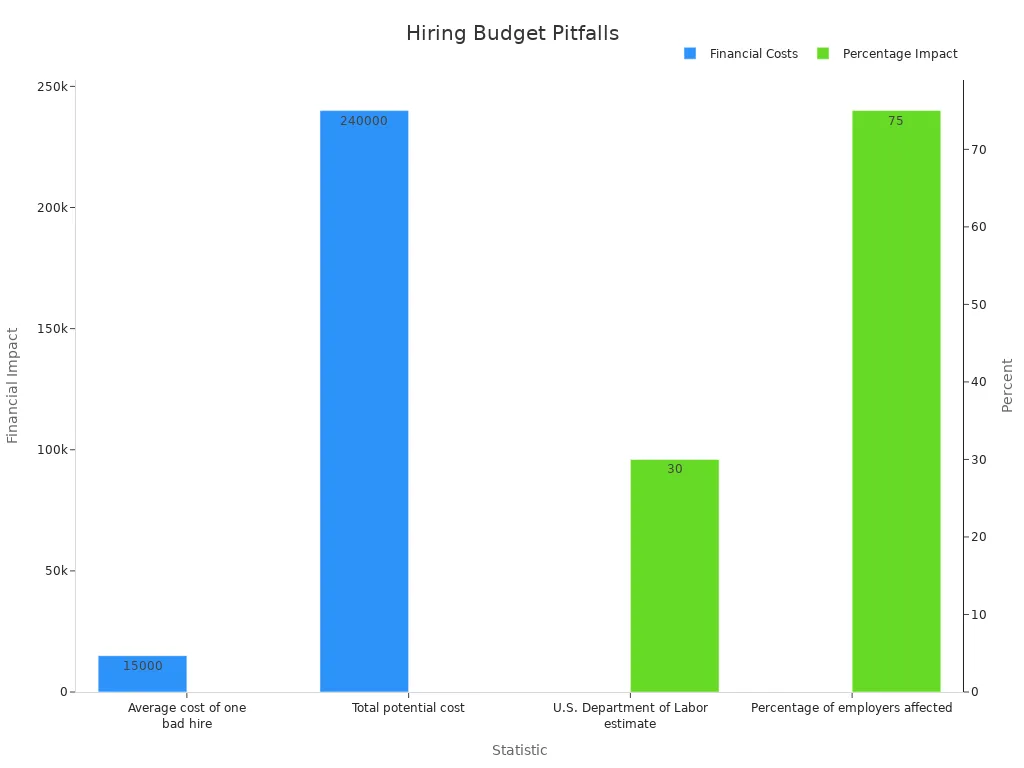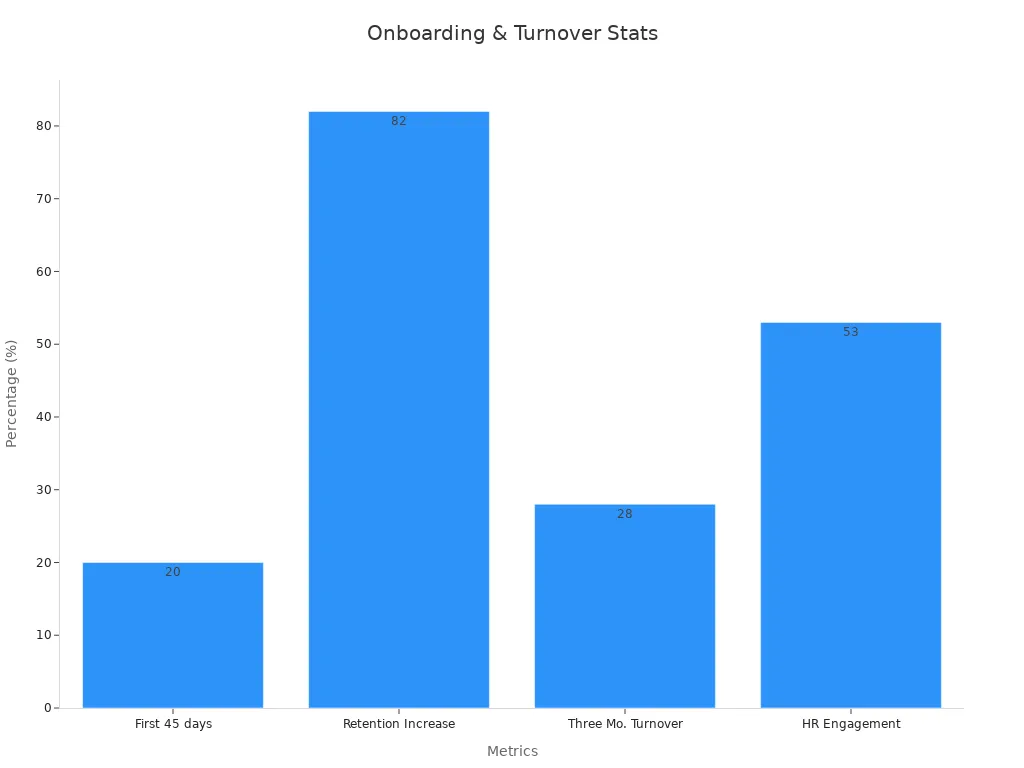How to Optimize Your Hiring Budget for Maximum Efficiency

Efficient hiring budgets play a pivotal role in driving organizational success in 2025. Companies that optimize their recruitment spending can achieve measurable results, such as reducing costs and attracting top-tier talent. For instance, a large retail chain cut hiring expenses by 25% by reallocating resources to effective platforms, while a technology firm saved 30% by streamlining its selection process. These examples highlight how understanding metrics like cost per hire and recruitment ROI can transform hiring strategies. With average merit increases projected at 3.3% and total increases at 3.7%, aligning hiring budgets with strategic goals ensures sustainable growth. Hiring budget efficiency: how to get the most out of your spend, is no longer optional—it’s essential.
Key Takeaways
Save money by using hiring funds on the best platforms. This helps you spend less and find better workers.
Use tools to predict how many workers you'll need. Matching hiring with company goals avoids too many hires and saves money.
Use technology like tracking systems to make hiring easier. This speeds up hiring and helps find better employees.
Create a strong group of potential workers by staying in touch. This reduces the need for expensive job ads.
Let others handle small hiring tasks to save time. This helps your team focus on important work and cut costs.
Hiring Budget Efficiency: How to Get the Most Out of Your Spend
What is a Hiring Budget and Why Does It Matter?
A hiring budget is a financial plan that outlines the resources allocated for recruitment activities. It includes expenses like job advertisements, recruiter salaries, and onboarding costs. This budget ensures that you can attract and hire the right talent without overspending. According to Deloitte's Cost-Per-Hire Benchmark Report (2024), the average cost-per-hire for U.S. companies is $4,700, with tech roles exceeding $6,000. Unfilled roles, on the other hand, cost organizations an average of $500 per day in lost productivity. These figures highlight the importance of managing your hiring budget efficiently to avoid unnecessary expenses and delays.
By optimizing your hiring budget, you can reduce costs while improving recruitment outcomes. For example, skills-based hiring has been shown to cut cost-per-hire by 30%, as reported by LinkedIn's Global Hiring Trends Report (2024). This approach not only saves money but also ensures that you hire candidates who are well-suited for the role.
Key Components of an Effective Hiring Budget
An effective hiring budget includes several key components that directly impact recruitment success. These components and their return on investment (ROI) are summarized in the table below:
Component | Description | Impact on ROI |
|---|---|---|
Sourcing and Outreach | Job advertising, networking events, job fairs, referral bonuses. | Directly influences candidate pool and hiring outcomes. |
Technology and Tools | Subscriptions for ATS, CRM, LinkedIn recruitment. | Boosts efficiency and quality of hires if leveraged effectively. |
Personnel | Recruiter salaries, external agency fees. | Essential for executing recruitment activities; optimizing team size is key. |
Training and Development | Ongoing education for recruiters. | Enhances team skills over time, contributing to better hiring outcomes. |
Marketing and Branding | Employer branding campaigns, candidate experience optimization. | Builds a strong talent pipeline, reducing costs in other areas significantly. |
Allocating resources to these areas ensures that your hiring process is both efficient and effective. For instance, investing in technology like applicant tracking systems (ATS) can streamline recruitment and reduce time-to-fill statistics.
Common Pitfalls in Managing Hiring Budgets
Mismanagement of hiring budgets can lead to significant financial losses. Common pitfalls include underestimating costs, failing to track expenses, and neglecting to measure recruitment ROI. The U.S. Department of Labor estimates that a bad hire can cost up to 30% of the employee’s first-year earnings. Additionally, direct costs of hiring can reach nearly $15,000 per employee.

To avoid these pitfalls, you should regularly review your hiring budget and adjust it based on performance metrics. For example, tracking cost-per-hire trends can help you identify areas where you can cut costs without compromising quality. A case study by CourseCareers (2025) found that clients reduced their average recruitment costs by $2,000 per hire through streamlined processes.
By understanding these challenges and addressing them proactively, you can maximize the efficiency of your hiring budget.
Practical Steps to Allocate and Optimize Your Hiring Budget

Forecasting Hiring Needs Based on Business Objectives
Accurately forecasting hiring needs ensures your recruitment efforts align with your company’s goals. Predictive analytics plays a vital role in this process. By using statistical models, you can analyze historical data to identify patterns that inform future hiring strategies. For example:
Predictive models assess factors like company growth rates, employee turnover, and industry trends.
These insights help you anticipate the number and types of roles required.
This approach ensures your hiring budget is allocated effectively to meet both immediate and long-term needs.
When you align hiring forecasts with business objectives, you avoid overstaffing or understaffing. This balance not only saves costs but also enhances overall hiring budget efficiency: how to get the most out of your spend.
Analyzing Historical Data to Identify Trends
Historical hiring data provides valuable insights into recruitment trends. By examining past performance, you can refine your strategies to improve efficiency. Key findings from data analysis include:
Leveraging AI for candidate screening improves efficiency in high-volume hiring.
Enhancing employer branding based on past data attracts top talent.
Embracing remote work has become a crucial trend, supported by statistical evidence.
Data-driven approaches streamline hiring processes and adapt to evolving recruitment landscapes. For instance, organizations that analyze recruitment statistics can identify areas to cut costs while maintaining quality. This analytical approach directly contributes to hiring budget efficiency: how to get the most out of your spend.
Leveraging Technology for Cost-Effective Recruitment
Technology has revolutionized recruitment, offering tools that reduce costs and improve outcomes. Case studies highlight measurable benefits:
Case Study | Measurable Benefit | Description |
|---|---|---|
Programmatic Advertising | Ensures job postings are cost-effective while improving application quality. | |
Vorecol HRMS | Streamlined recruitment process through integrated HRMS. | |
Talent Acquisition Technology | Lower recruitment costs | Automation of tasks and optimized job advertisements. |
By adopting these technologies, you can automate repetitive tasks, optimize job postings, and reduce overhead. This approach not only saves money but also enhances the quality of hires, ensuring your hiring budget is used efficiently.
Transitioning to a Variable Cost Model for Flexibility
Adopting a variable cost model for hiring can transform how you manage recruitment expenses. Unlike fixed costs, which remain constant regardless of hiring activity, variable costs adjust based on your organization’s needs. This approach provides the flexibility to scale your recruitment efforts up or down, aligning with business objectives and market conditions.
A variable cost model enhances agility in talent management. By shifting to this structure, you can allocate resources more efficiently and reduce operational overhead. For example, instead of maintaining a large in-house recruitment team during slower hiring periods, you can leverage external agencies or freelance recruiters on an as-needed basis. This strategy ensures you only pay for services when required, optimizing your budget.
Tip: Outsourcing non-essential hiring tasks, such as initial candidate screening, can significantly lower costs while maintaining quality.
Modern work practices, such as remote work and project-based hiring, align well with a variable cost model. You can adapt to these trends by utilizing contract workers or temporary staff for short-term projects. This approach not only reduces long-term financial commitments but also allows you to tap into a broader talent pool.
Benefits of transitioning to a variable cost model:
Greater flexibility to respond to fluctuating hiring demands.
Improved resource allocation for high-priority roles.
Enhanced ability to adapt to contemporary workforce trends.
By embracing this model, you position your organization to thrive in an ever-changing labor market. It empowers you to manage recruitment costs dynamically, ensuring your hiring budget remains efficient and effective.
Cost-Saving Strategies to Maximize Hiring Budget Efficiency

Building and Maintaining a Talent Network
A well-maintained talent network is a powerful tool for reducing recruitment costs. By nurturing relationships with potential candidates, you can create a pool of skilled professionals ready to fill roles as they arise. This proactive approach minimizes the need for expensive job advertisements and reduces time-to-hire.
To build a strong talent network, focus on consistent engagement. Use platforms like LinkedIn to share industry insights, company updates, and job opportunities. Hosting webinars or participating in industry events also helps establish your organization as an employer of choice. As Harry Morton, Founder of Lower Street, explains:
“Having this steady stream of skilled professionals at your fingertips is a game-changer. It ensures we’re always ready to tackle new projects, adapt to client demands, and scale our operations without the challenge of prolonged hiring processes.”
Promoting Employee Referrals with Incentives
Employee referral programs are among the most cost-effective recruitment strategies. They leverage your existing workforce to identify and recommend qualified candidates. Successful programs are simple, measurable, and clearly communicated to employees.
Referred candidates take an average of 29 days to hire, compared to 39 days from job boards and 55 days from career sites.
Referred employees stay 70% longer than non-referral hires, with a retention rate of 46% compared to 33% for job board hires.
Incentives play a crucial role in motivating employees to participate. Offer rewards such as cash bonuses, extra vacation days, or public recognition. These incentives not only encourage referrals but also foster a sense of ownership among employees in the hiring process.
Reducing Turnover Through Effective Onboarding
Effective onboarding reduces turnover and maximizes the return on your hiring investment. A structured onboarding process helps new hires integrate quickly, boosting engagement and productivity.
Statistic | Source |
|---|---|
The first 45 days of employment account for up to 20% of employee turnover. | HarvardBusinessReview, 2018 |
Good onboarding processes can increase retention levels by 82%. | BrandonHallGroup |
28% of recruits leave their jobs after three months. | HRDive, 2017 |
53% of HR professionals say an improved onboarding process increases employee engagement. | State of Talent, 2017, SilkRoad report |

Investing in onboarding ensures new employees feel supported and aligned with company goals. This reduces turnover costs and strengthens your hiring budget efficiency: how to get the most out of your spend.
Outsourcing Non-Essential Hiring Tasks
Outsourcing non-essential hiring tasks can significantly improve your recruitment efficiency while reducing costs. By delegating administrative and repetitive functions to external providers, you free up internal resources to focus on strategic priorities. This approach allows your team to concentrate on core competencies, such as talent strategy and employee engagement, while outsourcing partners handle operational tasks like candidate screening and background checks.
Outsourcing offers measurable benefits that directly impact your hiring budget. For example:
Outcome Type | Description |
|---|---|
Labor Cost Reduction | Access global talent at lower costs compared to in-house teams. |
Overhead Expense Reduction | Avoid significant capital expenses by utilizing the infrastructure of outsourcing providers. |
Process Efficiency Improvement | Optimize workflows, enhancing performance and satisfaction, leading to cost savings. |
Flexible Cost Management | Operate on a pay-as-you-go model, scaling operations based on demand. |
These advantages make outsourcing an attractive option for companies aiming to streamline expenses and improve recruitment outcomes.
Outsourcing providers often leverage advanced technologies to enhance efficiency. Their expertise in applicant tracking systems (ATS), artificial intelligence (AI), and data analytics ensures faster and more accurate candidate selection. This reduces recruitment and training costs while improving the overall quality of hires. Additionally, outsourcing partners can adapt to fluctuating hiring demands, offering flexibility that in-house teams may struggle to achieve.
Tip: Focus on outsourcing tasks that require minimal strategic input, such as resume parsing or initial candidate outreach. This ensures your internal team remains dedicated to high-value activities.
By outsourcing non-essential hiring tasks, you gain access to specialized skills and infrastructure without the burden of maintaining them in-house. This approach not only saves money but also positions your organization to respond quickly to changing market conditions.
Key Considerations for Long-Term Budget Optimization
Aligning Hiring Budgets with Strategic Goals
Aligning your hiring budget with broader strategic goals ensures that recruitment efforts directly contribute to organizational success. This approach allows you to allocate resources where they create the most value. For example:
Optimized workforce planning helps you focus on talent initiatives that drive measurable outcomes.
Integrating employee data with financial metrics enhances decision-making and highlights trends that support growth.
Increased organizational agility enables you to adapt to market changes, ensuring long-term stability.
By aligning your hiring budget with strategic objectives, you create a roadmap that balances immediate needs with future opportunities. This alignment also fosters better collaboration between HR and leadership, ensuring that recruitment strategies support overall business priorities.
Adapting to Labor Market Trends and Conditions
Understanding labor market trends is essential for effective budget planning. Reliable data helps you anticipate changes and adjust your hiring strategies accordingly. Key metrics include:
Metric Type | Description |
|---|---|
Occupational Wages | Measures wage trends across occupations, aiding in competitive salary planning. |
Employment Trends | Tracks employment levels to gauge labor market dynamics. |
Skills Demand | Identifies in-demand skills, allowing you to prioritize critical roles. |
Labor Demand Flows | Provides insights into hiring needs by occupation, guiding budget allocation. |
Technology Impact | Highlights how technological advancements influence labor market trends and hiring strategies. |
By leveraging these insights, you can allocate resources to high-demand areas and remain competitive in a rapidly evolving market. This proactive approach ensures your hiring budget remains flexible and effective.
Prioritizing Diversity, Equity, and Inclusion in Recruitment
Prioritizing diversity, equity, and inclusion (DEI) in recruitment not only enhances workplace culture but also drives financial performance. Research shows that organizations with strong DEI strategies experience a 35% boost in financial outcomes compared to less inclusive peers. Additionally, integrating DEI into business processes has been linked to improved metrics such as return on assets and net income.
Focusing on DEI also opens doors to new markets, fosters innovation, and increases employee engagement. By embedding DEI principles into your hiring practices, you create a more inclusive workforce that reflects diverse perspectives. This approach not only strengthens your organization’s reputation but also ensures long-term success in a competitive business environment.
Balancing Immediate Costs with Long-Term Value
Balancing immediate cost reduction with long-term value creation is essential for sustainable success. While cutting expenses may seem like the quickest way to optimize your hiring budget, focusing solely on short-term savings can harm your organization’s future growth. You need to adopt a strategy that aligns cost management with both current needs and long-term objectives.
One effective approach is to prioritize investments that drive innovation and growth. For example, reducing budgets for research and development (R&D) or employee training might save money now, but it could limit your ability to attract top talent or adapt to market changes later. Instead, focus on reallocating resources to areas that yield high returns over time, such as employer branding or advanced recruitment technologies.
Tip: Engage your employees in the cost-cutting process. Their insights can uncover inefficiencies and lead to both immediate savings and lasting improvements.
Here are some principles to guide your decision-making:
Avoid cutting budgets that stifle innovation, such as R&D or technology upgrades.
Invest in tools and strategies that enhance efficiency, like applicant tracking systems (ATS).
Align cost-saving measures with your organization’s core values and strategic goals.
Balancing costs also requires a forward-thinking mindset. For instance, while outsourcing non-essential tasks may reduce expenses now, it also frees up internal resources to focus on strategic initiatives. Similarly, building a strong talent network reduces reliance on expensive job advertisements, creating long-term savings.
By balancing immediate cost reductions with long-term value creation, you ensure your hiring budget supports both short-term efficiency and future growth. This approach not only strengthens your organization’s financial health but also positions you as a competitive employer in the evolving labor market.
Optimizing your hiring budget is essential for achieving organizational success. Efficient budget management reduces costs, improves recruitment outcomes, and aligns hiring efforts with strategic goals. Key strategies include leveraging technology, building a talent network, and transitioning to flexible cost models.
Take Action: Begin by analyzing your current hiring processes. Identify inefficiencies, set measurable goals, and implement data-driven solutions.
By refining your hiring budget for 2025, you position your organization to attract top talent, adapt to market trends, and achieve sustainable growth. Start today to maximize your recruitment ROI.
FAQ
What is the ideal percentage of revenue to allocate for hiring budgets?
Experts recommend allocating 10-15% of your revenue for hiring, depending on your industry and growth stage. For startups, this percentage may be higher due to rapid scaling needs. Regularly review your budget to ensure alignment with business goals.
How can I measure the ROI of my hiring budget?
Track metrics like cost-per-hire, time-to-fill, and employee retention rates. Compare these against industry benchmarks. Use tools like applicant tracking systems (ATS) to gather data and analyze trends. This ensures your spending delivers measurable results.
Should I prioritize technology investments in my hiring budget?
Yes, investing in recruitment technology improves efficiency and reduces costs. Tools like ATS, AI-driven screening, and programmatic advertising streamline processes. These technologies enhance candidate quality and save time, making them essential for modern hiring strategies.
How often should I review my hiring budget?
Review your hiring budget quarterly to adapt to changing business needs and market conditions. Regular reviews help identify inefficiencies, track performance, and reallocate resources effectively. This ensures your budget remains optimized throughout the year.
Can outsourcing recruitment save money?
Outsourcing non-essential tasks like candidate screening or background checks reduces costs. It allows your team to focus on strategic priorities. Outsourcing partners often use advanced tools, providing cost-effective solutions while maintaining high-quality hires.
See Also
Streamline Your Hiring Process With These 10 Effective Tips
Enhance Your Recruitment Strategy Using MokaHR's ATS and CRM
The Role of Recruitment Management Systems in Candidate Selection
Make Your Hiring Process Easier With MokaHR's Talent System
Boost Your Hiring Efficiency Using MokaHR's Recruitment System
From recruiting candidates to onboarding new team members, MokaHR gives your company everything you need to be great at hiring.
Subscribe for more information

